MARIANI’S
November
7,
22,
2010
NEWSLETTER
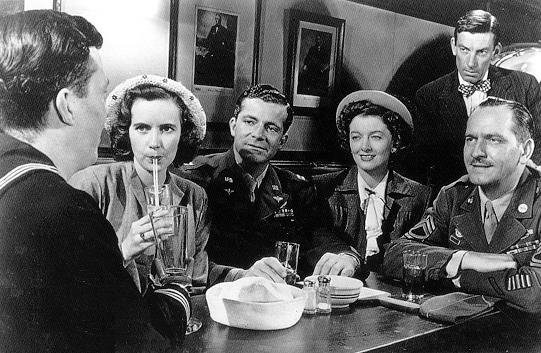
Harold
Russell, Teresa Wright, Dana Andrews, Myrna Loy, Hoagy Carmichel and
Fredrick March in "The Best Years of Our Lives" (1946)
REMEMBER VETERAN'S DAY
~~~~~~~~~~~~~~~~~~~~~~~~
➔ QUESTIONS? TO REACH JOHN MARIANI WRITE TO: newsletter@johnmariani.com.
➔ ARCHIVE: Readers may now access an Archive of all past newsletters--each annotated--dating back to July, 2003, by simply clicking on www.johnmariani.com/archive
➔ SUBSCRIBE AND
UN-SUBSCRIBE: You may subscribe anyone you wish
to this newsletter--free of charge--by
clicking here.
GOOD
NEWS! Esquire.com now
has
a
new
food
section
called
"Eat
Like
a
Man,"
which
will
be
featuring
restaurant
articles
by
John
Mariani
and
others
from
around
the
USA.
~~~~~~~~~~~~~
☛ In
This Issue
GUATEMALA's GRANDEUR
by
Christopher Mariani
NEW YORK CORNER:
Jubilee
by
John
Mariani
by Christopher Mariani
NOTES FROM THE SPIRITS LOCKER: Whiskey Americana by John Mariani
QUICK BYTES
~~~~~~~~~~~~~
GUATEMALA'S GRANDEUR
by Christopher Mariani
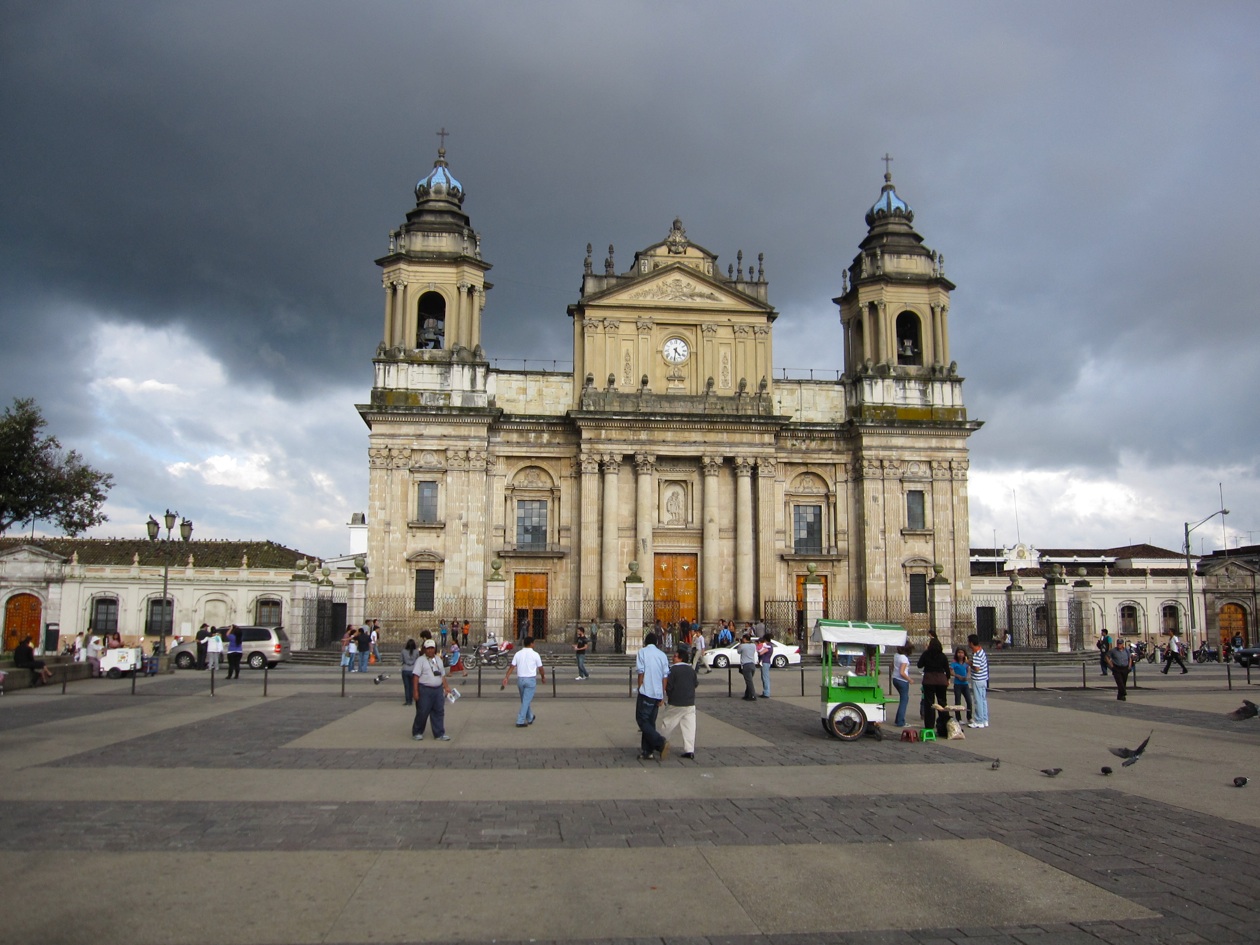 When
I
heard
I
was
heading down to Guatemala,
I was
little unsure what to expect, so when I booked
my trip, knowing little about where to go and what to see, I reached
out to
René Meier, one of the best
tour guides
in the
country. René is originally from
Switzerland, so if you call him, don’t hang up when you hear his voice
and
think you have called the wrong number because of his thick Swiss
accent; don’t
worry, he also speaks Spanish. How
he ventured from Switzerland to Guatemala is a question I couldn’t
answer, but
I’m sure there’s quite a story.
When
I
heard
I
was
heading down to Guatemala,
I was
little unsure what to expect, so when I booked
my trip, knowing little about where to go and what to see, I reached
out to
René Meier, one of the best
tour guides
in the
country. René is originally from
Switzerland, so if you call him, don’t hang up when you hear his voice
and
think you have called the wrong number because of his thick Swiss
accent; don’t
worry, he also speaks Spanish. How
he ventured from Switzerland to Guatemala is a question I couldn’t
answer, but
I’m sure there’s quite a story.
Once in
Guatemala I quickly realized the country is not financially rich but
extremely
rich in culture and history. During my
stay, I climbed the Mayan pyramids of Tikal,
toured and
partied in the city of Antigua, visited the Lanquín Caves, swam
in the
natural
water springs of Semuc Champey, went white water rafting down the
Río
Cahabón
River, zipped down the mountainside of Finca Filadelfia by way of
canopy, and
hiked to the top of the Pacaya Volcano, still very active at the time
of my
visit, erupting just three months prior.
My journey began in Guatemala City, where I
exited
the La Aurora International Airport, got into a tiny unmarked taxi and
asked
the driver to bring me to the very modern Grand Tikal Futura
Hotel . On the way to
the hotel we whizzed through the crowded
streets, filled with thousands of small cars, hundreds of little
motorcycles and
mopeds,
some surprisingly seating more than two adults, and many red public
transportation
buses (the city has no subway system). The
main strips were sided by small markets, street
vendors,
restaurants, a few modern buildings, and beautiful architecture, old
cathedrals
and enormous city squares. Once at
the Grand Tikal Futura, I checked into an enormous
room
that offered a terrific panoramic view of the city, followed by a quick
lunch
at the hotel’s restaurant, La Molienda,
pleasant,
but
not worth missing
out on
the restaurants within the city.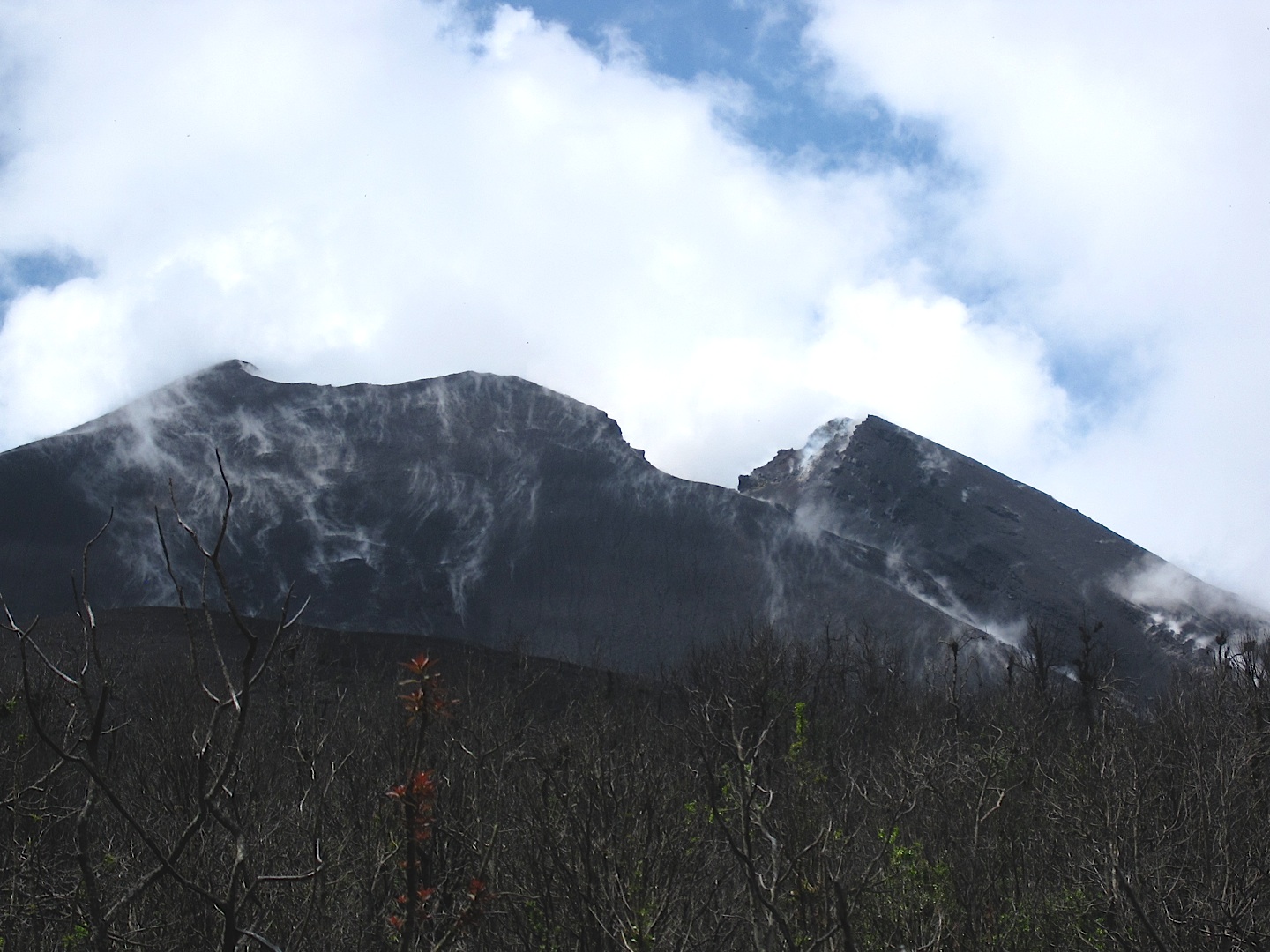
My
first adventure, just outside of Guatemala City, was a four-hour hike
up and
down the still-active Pacaya volcano (right). René
and
I
started at the base where
we were immediately
approached by a horse and his owner, who politely asked if either of us
would
like to pay ten dollars to have the horse take us up and down the steep
volcano. We both declined the
offer and started hiking up the first quarter of the volcano, looking
back
after a few minutes to see the gentleman and his horse following. The gentleman looked up at us and said,
“I’m here in case you get tired.” This guy
was a true salesman, he followed us for over two
hours yet
never made a sale.
As we ascended up the front of the
volcano, the terrain
became more
challenging and the tilt increasingly steep. The
ground
was
blanketed
with black volcanic rock and
hardened ash from the eruption just three months prior, which covered the entire mountainside in just
30 minutes, destroying the local towns and burning the branches and
leaves off
every single tree in sight, not an ounce of shade that afternoon. Finally at the top, as my lungs burned
and my thighs cramped, I looked out at the grayish black volcano peak
that
released steam and smoke, a daunting reminder that we were on top of an
active
volcano.
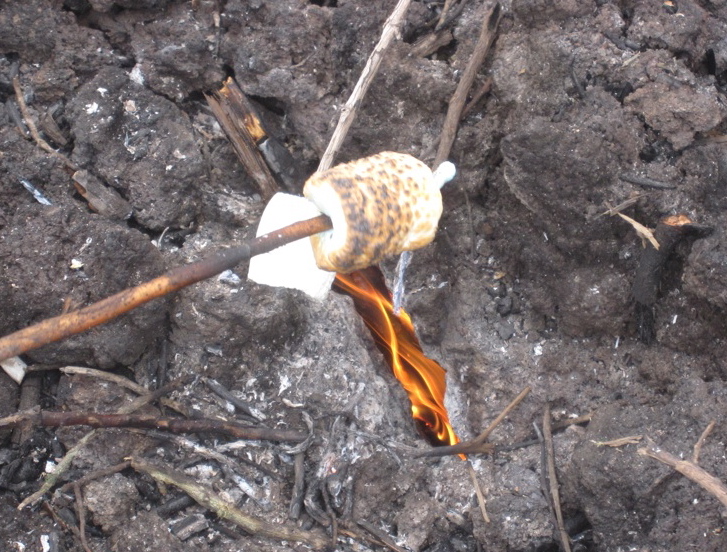 After a bottle of
water and a Granola Bar we
begin
our descent down the opposing side of the volcano.
During this section of the hike, the dried volcanic
pebbles
were six inches deep and very loose, causing my boots to nearly
disappear with
each step. The decline appeared almost
vertical, and as crazy as this may sound, the faster you charged down
the
slope, the easier if was on your thighs, almost like skiing. We then stopped at a very hazy section
of the volcano where the smoke and heat rose out of every crack in the
hardened
black lava. René then pulled out a
bag of marshmallows and insisted on having a snack.
He placed kindling a few inches into the cracks
of the black rocks, and within seconds the branches went up in flames. We indulged in a bag of marshmallows
roasting them with the natural fire from the volcano.
Only in Guatemala.
After a bottle of
water and a Granola Bar we
begin
our descent down the opposing side of the volcano.
During this section of the hike, the dried volcanic
pebbles
were six inches deep and very loose, causing my boots to nearly
disappear with
each step. The decline appeared almost
vertical, and as crazy as this may sound, the faster you charged down
the
slope, the easier if was on your thighs, almost like skiing. We then stopped at a very hazy section
of the volcano where the smoke and heat rose out of every crack in the
hardened
black lava. René then pulled out a
bag of marshmallows and insisted on having a snack.
He placed kindling a few inches into the cracks
of the black rocks, and within seconds the branches went up in flames. We indulged in a bag of marshmallows
roasting them with the natural fire from the volcano.
Only in Guatemala.
That
night, we dined at the hotel, and even though I had a long day of
travel
awaiting me the following morning, I splashed some cold water on my
face,
jumped in a cab and headed to Guatemala City’s Zona Viva, a vibrant
section of
the city filled with night clubs, bars and restaurants.
Not having a clue as to where to go and
seated next to a taxi driver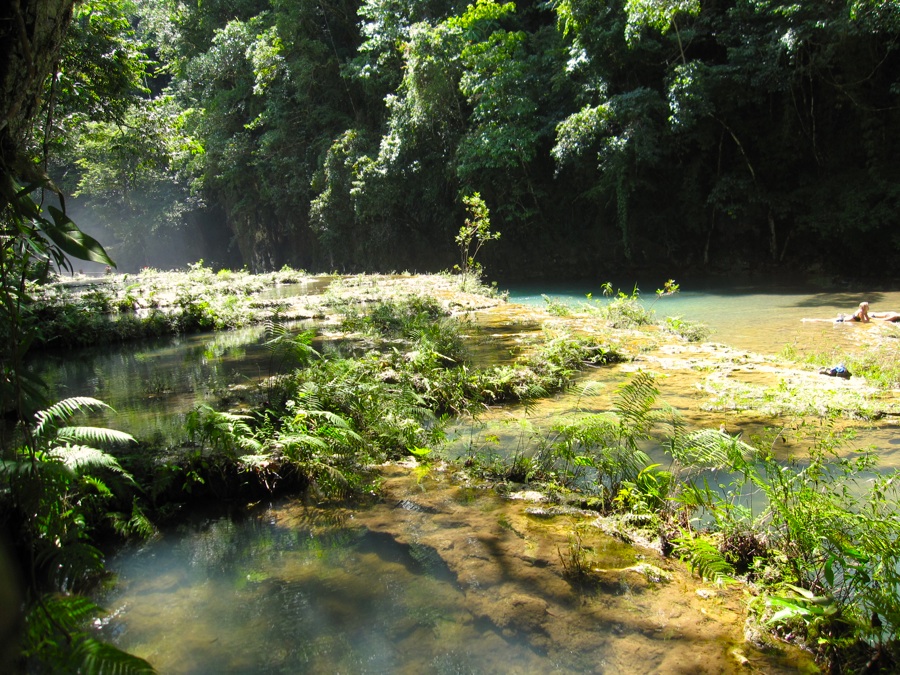 who spoke not a word of English, I asked
him to parada at the first sign of load
music. I exited the taxi and
entered a nightclub called Taboo, filled with young people, great
music, a huge
dance floor, and a long bar where I found myself sitting with a nice
cold Gallo
beer in hand. Within a short
amount of time, I had found some young Guatemalans in their mid-20’s
who spoke
just enough English for us to communicate, and later in the night a
beautiful
young lady to dance with until closing.
who spoke not a word of English, I asked
him to parada at the first sign of load
music. I exited the taxi and
entered a nightclub called Taboo, filled with young people, great
music, a huge
dance floor, and a long bar where I found myself sitting with a nice
cold Gallo
beer in hand. Within a short
amount of time, I had found some young Guatemalans in their mid-20’s
who spoke
just enough English for us to communicate, and later in the night a
beautiful
young lady to dance with until closing.
The following day began at 5 am, so after a
tall
glass of water and a handful of Advil, it was off to Lanquin, a
seven-hour
drive from Guatemala City, most of which I slept through.
Finally arriving in Lanquín, I checked
into the very modest El Recreo Hotel, changed into my
bathing suit, then jumped
onto the
back of a pickup truck for a 45-minute drive to the beautiful natural
pools of
Semuc Champey. The placid pools (above)
are filled with crystalline natural spring water that gently flows from
one to the next, where families either swim in the fresh water or
just
lounge
by the water’s edge.
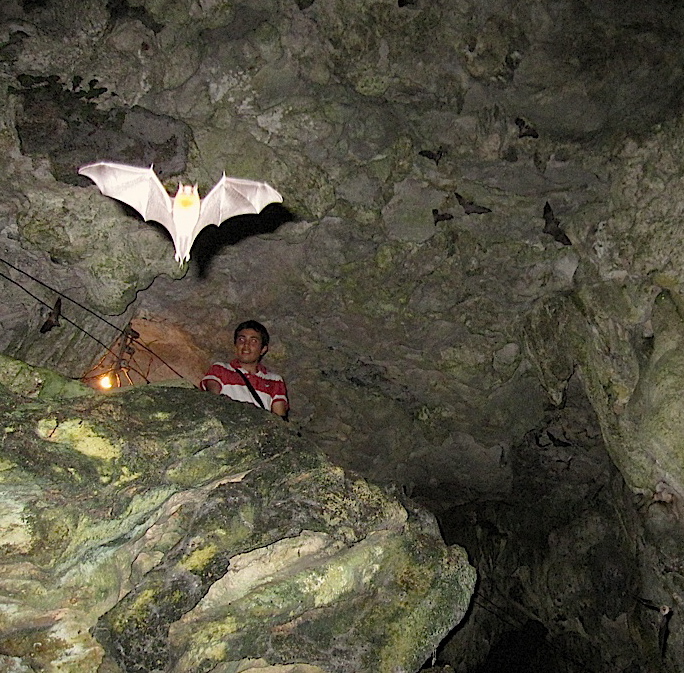 After
a
few
hours, lunch, and some local
chocolate
cookies, René and I headed to the Lanquín Caves to
explore the
darkness
of the underworld. The caves are
massive, stretching hundreds of feet in width and depth, filled with
multiple
chambers of various shapes and sizes, with monumental limestone
foundations,
and
enormous hanging stalactites. The
best time to visit the caves is at 6:30 in the evening when thousands
of bats exit
the
mouth of the cave (left). The bats shoot
out by the hundreds, blanketing the dark blue sky, an unforgettable
spectacle
that lasted for about fifteen minutes.
After
a
few
hours, lunch, and some local
chocolate
cookies, René and I headed to the Lanquín Caves to
explore the
darkness
of the underworld. The caves are
massive, stretching hundreds of feet in width and depth, filled with
multiple
chambers of various shapes and sizes, with monumental limestone
foundations,
and
enormous hanging stalactites. The
best time to visit the caves is at 6:30 in the evening when thousands
of bats exit
the
mouth of the cave (left). The bats shoot
out by the hundreds, blanketing the dark blue sky, an unforgettable
spectacle
that lasted for about fifteen minutes.
The following morning we woke up early,
charged up
on some eggs, toast and strong Guatemalan coffee before driving to the
Río
Cahabón River for some Class Four white water rafting. I have rafted in the past but nothing
has got ten my adrenaline going like the Cahabón River. The rapids were tremendous, tossing the raft
up and down
at
will as my captain and crew did their best to keep the raft facing
forward. We successfully made it through
the
rapids and when the river calmed, we enjoyed the scenic imagery of the
Q’eqchi
community of Saquijá. Hours later,
exhausted and depleted of energy, we headed back to Guatemala City for
the
night, had a few Gallo beers, and a shot or two of Ron Zacapa 23-year
old añejo
rum to celebrate our conquest of the river.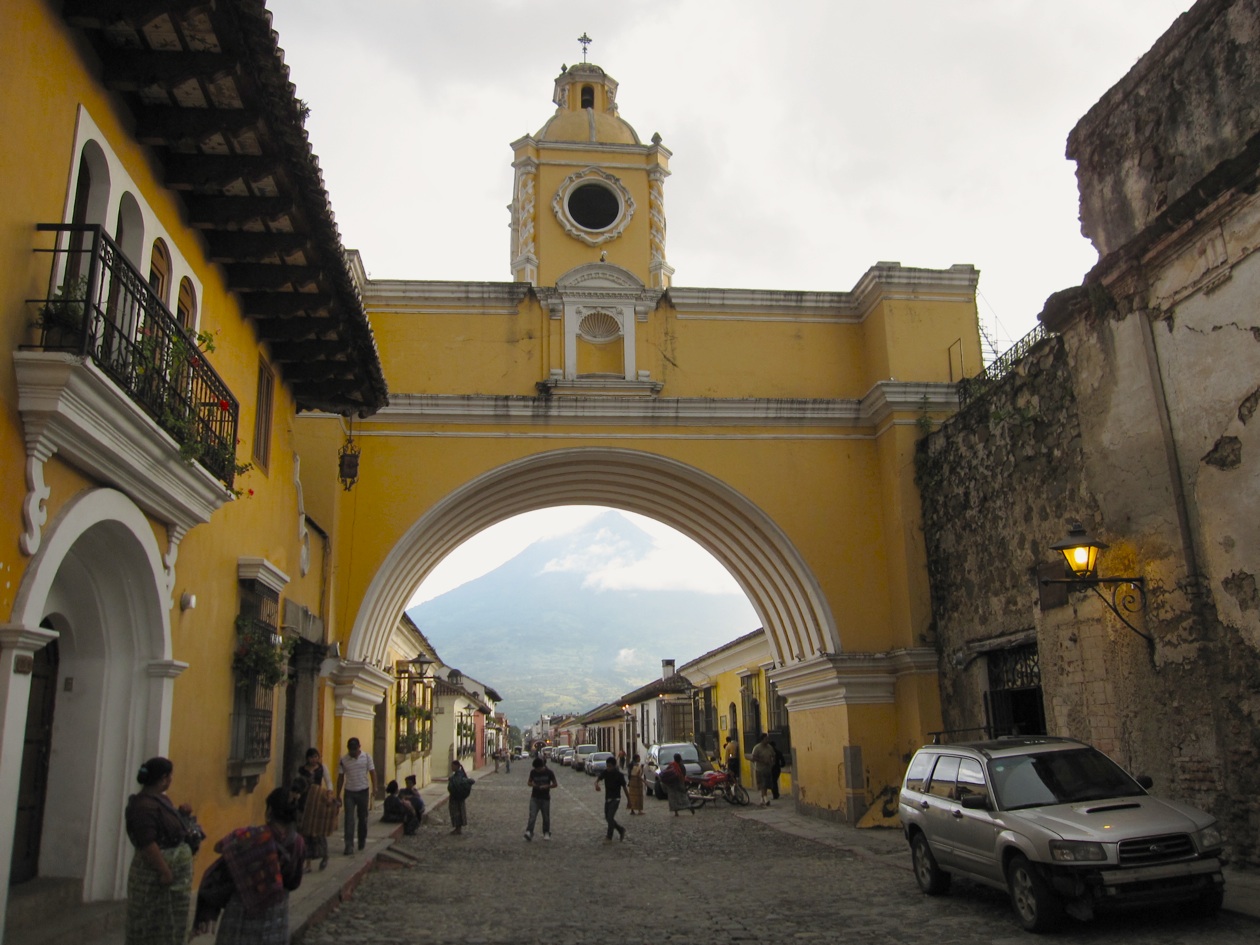
The following morning we were off to the city
of
Antigua (right).
I began my exploration on
the main streets, where I found great little coffee cafes and huge
shopping
markets filled with every conceivable item you could possibly think of
and
seemingly charming little children who should be teaching “Sales 101”
in major
U.S. universities, speaking
perfect English, extremely persisitent until they convinced me to buy
their colorful native costume jewelry.
We ate at one particularly traditional Guatemalan
restaurant called La
Fonda de la Calle Real (below), a favorite of Bill
Clinton, whose photos of dining at the restaurant are all over the
entrance
walls. The restaurant has a
gorgeous outside dining area surrounded by two floors of pink-and-white
balconies,
potted plants, quaint little green tabletops surrounded by metal framed
chairs, and an outside open kitchen where just two chefs cook up all
the
dishes. I ate indoors that
afternoon because of the rainy weather, beginnng with an order of the caldo de gallina soup, a very typical
lunch or dinner item throughout all of Guatemala. The
soup
is
a
chicken
broth,
seasoned
with mint, chili and
cilantro, filled with large chunks of boiled potatoes and tomatoes,
bone-in 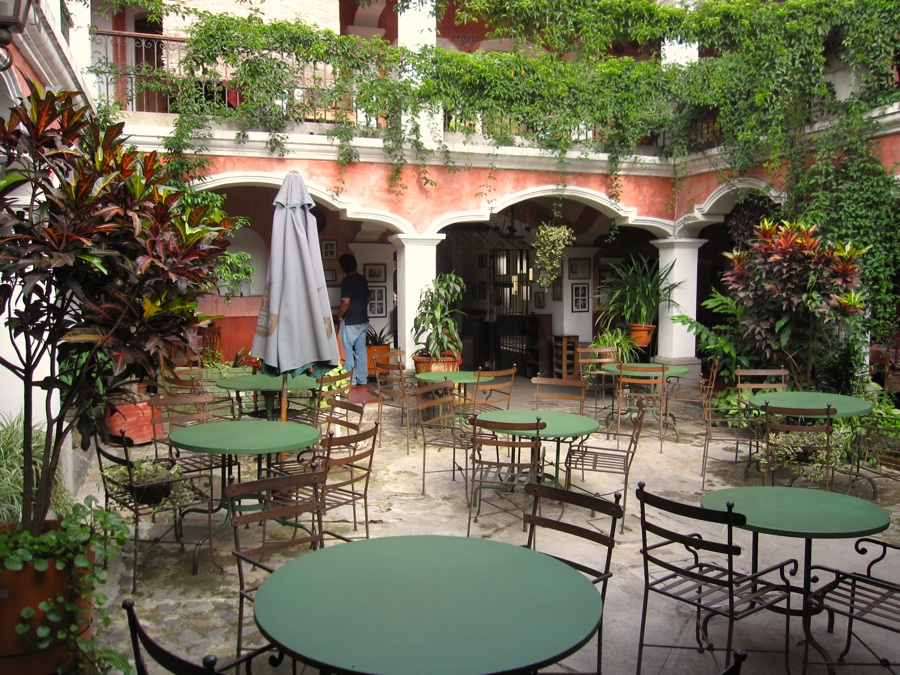 chicken
breasts, sided by sliced limes, chopped raw onions, and chili powder.
chicken
breasts, sided by sliced limes, chopped raw onions, and chili powder.
The caldo de
gallina (below)
is a meal in itself, but I had to try the famous
Guatemalan pepian de pollo. The
chicken
is
served
with
vegetables
smothered
in
a roasted tomato sauce made with chilies, cinnamon, and
pumpkin,
sided by white rice and a corn tamale.
The dish was hearty, full of
flavor, and one of my favorite foods of Guatemala.
The pepian de polo does
seem to be a competitive dish among Guatemalan chefs--I won’t name
names but
every single chef who made this dish was adamant that theirs was the
best.
I skipped
dessert,
finished
the
last of my Gallo beer,
passed by the
restaurant’s
beautiful hostess and headed to Cookies,
Ect. [sic], on the
corner of 3a
Avenue and
4ta for something sweet.
The tiny café serves terrific teas,
coffees, and best of all, fresh cookies served hot out of the oven. After three cookies and a cup of coffee,
I found my way to the real street market on Antigua, filled 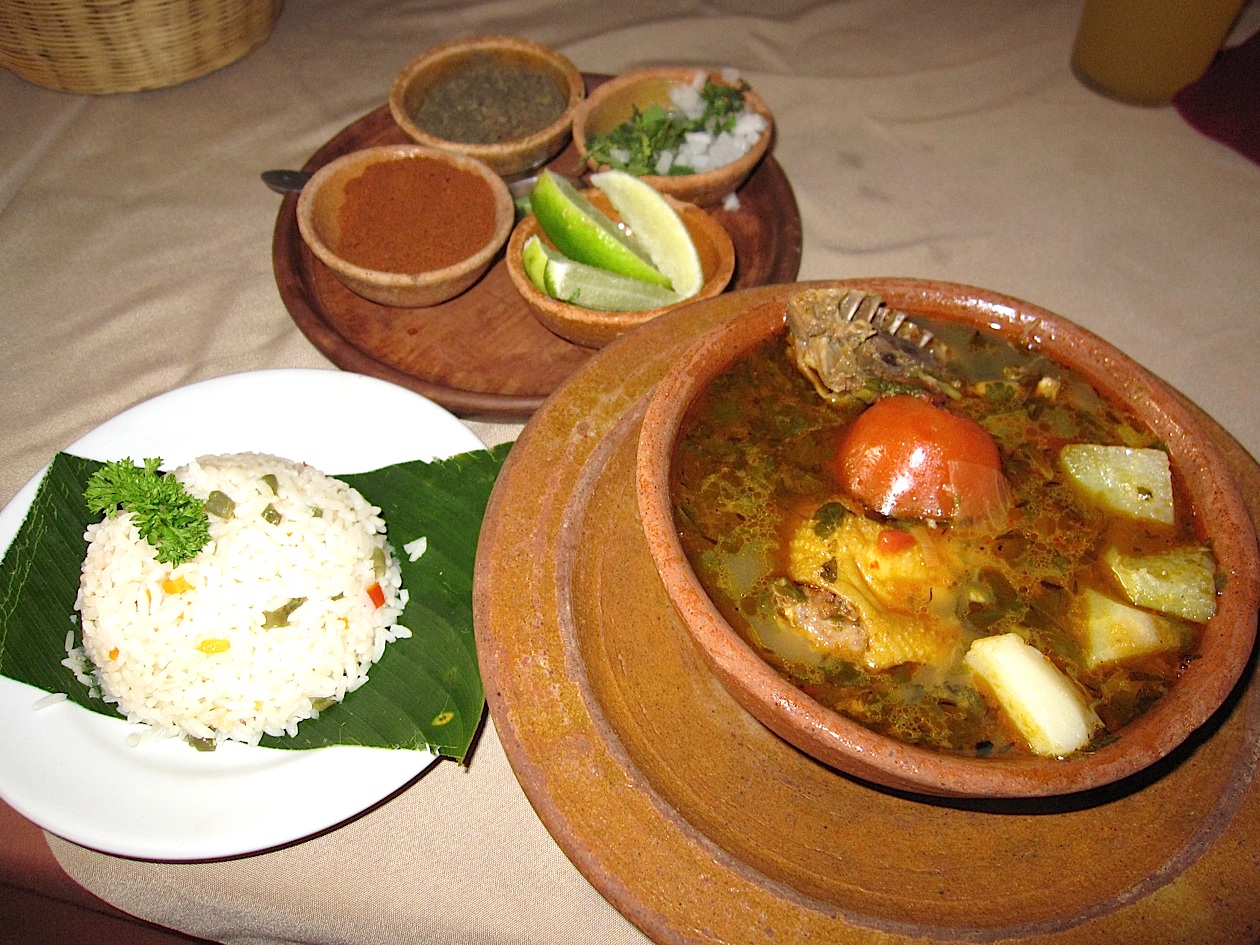 with vendors
selling clothes, hats, bags, jewelry, toys, and much more.
To the naked eye, the outside market
that borders the street’s buildings seem to mark the perimeter of the
market,
but look closely and you will see little openings where you enter
into a
whole new world. The indoor market
must be two football fields wide, filled with narrow maze-like alleys,
endless
stores, stairwells to stores upstairs selling watches, electronics,
bags, and
even live chickens and pets. Do
not attempt to remember how many lefts and rights you took,
just keep a
constant idea of what direction you came from. You
will
never
exit
the
same
opening
you originally entered,
but you will most likely exit onto the same street.
I even witnessed a street performer charming a cobra
snake, and drinking a glass of fruit juice and cow's eyeballs--cut in
front of me--somehow
trying
to explain and convince the crowd to buy these little ginseng bottles
he was
attempting to sell. As the
rainfall began to increase, we headed to our hotel, the Villa Colonial ,
for shelter and rest.
with vendors
selling clothes, hats, bags, jewelry, toys, and much more.
To the naked eye, the outside market
that borders the street’s buildings seem to mark the perimeter of the
market,
but look closely and you will see little openings where you enter
into a
whole new world. The indoor market
must be two football fields wide, filled with narrow maze-like alleys,
endless
stores, stairwells to stores upstairs selling watches, electronics,
bags, and
even live chickens and pets. Do
not attempt to remember how many lefts and rights you took,
just keep a
constant idea of what direction you came from. You
will
never
exit
the
same
opening
you originally entered,
but you will most likely exit onto the same street.
I even witnessed a street performer charming a cobra
snake, and drinking a glass of fruit juice and cow's eyeballs--cut in
front of me--somehow
trying
to explain and convince the crowd to buy these little ginseng bottles
he was
attempting to sell. As the
rainfall began to increase, we headed to our hotel, the Villa Colonial ,
for shelter and rest.
That
evening after dinner I ventured back into the heart of Antiqua and
found a
great little jazz bar called El
Ocelote Bar Restaurante on 4ta Avenue
Norte, #3
(the white house opposite a sign reading "Riki’s")
that
had
live
music until 11pm. The music was
great, the crowd lively, the drinks cold, and the
female Alaskan bartender very good-looking. I
spent
the
night
dancing and tasting all different types
of añejo rum
before I headed back to the hotel for some rest.
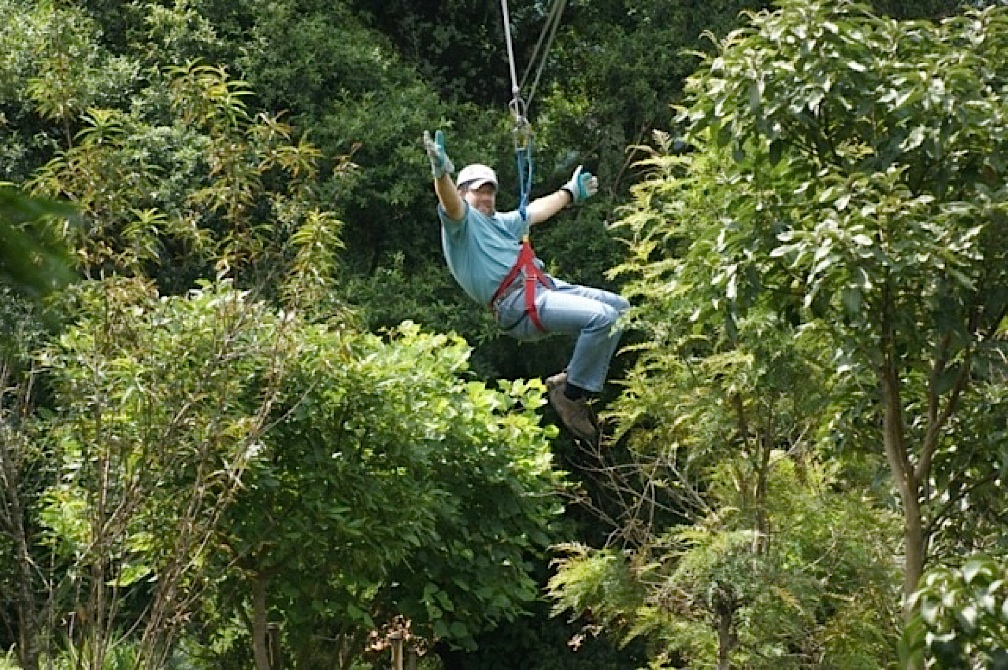 The
following
morning
we
headed to Finca
Filadelfia
for a tasting of Guatemala’s best coffee, followed by a turn on the
canopy zip
lines (left).
We climbed up 3,000 feet in
an army green Mercedes military truck, almost to the top of the
mountain
and
flew back down on a seven-course zip line. The
view
was
spectacular
and
the
ride
down was thrilling,
some of the courses over 45 seconds long. As
long
as
you’re
not
petrified
of heights, I would not
miss the Antigua
Canopy Tours.
The
following
morning
we
headed to Finca
Filadelfia
for a tasting of Guatemala’s best coffee, followed by a turn on the
canopy zip
lines (left).
We climbed up 3,000 feet in
an army green Mercedes military truck, almost to the top of the
mountain
and
flew back down on a seven-course zip line. The
view
was
spectacular
and
the
ride
down was thrilling,
some of the courses over 45 seconds long. As
long
as
you’re
not
petrified
of heights, I would not
miss the Antigua
Canopy Tours.
The
last
leg
of
my
journey through Guatemala
was to
Petén, where I witnessed and climbed the ancient Mayan pyramids
and
temples of Yaxhá and Tikal. Day
one,
we
visited
the archeological site of Yaxhá, which was once home to an
entire
Mayan
city, buried deep within the jungle for thousands of years. Many of the temples have not been
excavated on purpose, still covered by the grass, weeds and foliage
that offer
protection to the very delicate limestone construction.
These un-excavated temples appear like
giant natural mounds of dirt and trees and to 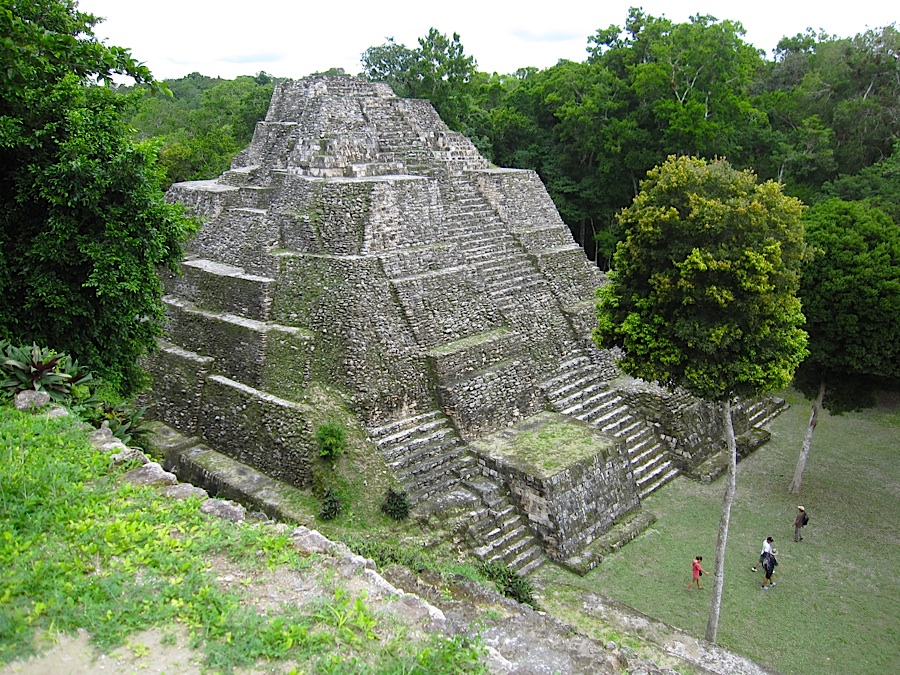 the
naked
eye
could
easily be
mistaken for a hill. It was not
until René pointed it out to me that I realized the dirt hills
were
actually
temples and pyramids. Even the
grass and jungle floor we walked on were actually tremendous limestone
plazas,
public squares, streets and sidewalks. As
I ventured through the jungle and acquired a better
sense of the
city's size and design, I slowly began to imagine myself walking
through a
Mayan city, seeing temples and buildings, as opposed to just grassy
hills. At the base of one of the largest
temples of Yaxhá (right),
René
said “Follow me, “ as he climbed to the
top, overlooking
the entire city and I finally understood how large this vast city was. René explained that only the priests
were allowed to climb the towers, for only they were worthy of being so
high up
in the sky and physically closer to God than anyone below.
It was surreal to think that where I
was standing, thousands of years prior, there had been priests
conducting
ceremonies high above thousands of people, possibly partaking in sacrificial religious ceremonies.
The hike down the temple was not easy,
extremely steep, and of course with no safety cords preventing me from
becoming a
present-day sacrifice.
the
naked
eye
could
easily be
mistaken for a hill. It was not
until René pointed it out to me that I realized the dirt hills
were
actually
temples and pyramids. Even the
grass and jungle floor we walked on were actually tremendous limestone
plazas,
public squares, streets and sidewalks. As
I ventured through the jungle and acquired a better
sense of the
city's size and design, I slowly began to imagine myself walking
through a
Mayan city, seeing temples and buildings, as opposed to just grassy
hills. At the base of one of the largest
temples of Yaxhá (right),
René
said “Follow me, “ as he climbed to the
top, overlooking
the entire city and I finally understood how large this vast city was. René explained that only the priests
were allowed to climb the towers, for only they were worthy of being so
high up
in the sky and physically closer to God than anyone below.
It was surreal to think that where I
was standing, thousands of years prior, there had been priests
conducting
ceremonies high above thousands of people, possibly partaking in sacrificial religious ceremonies.
The hike down the temple was not easy,
extremely steep, and of course with no safety cords preventing me from
becoming a
present-day sacrifice.
 The following day we visited the even grander
temples of Tikal, a Mayan city far greater in size and height than
Yaxhá. At the Tikal National Park,
I
witnessed
some of the most amazing man-made architecture ever created. I am talking about a city constructed
and filled with enormous religious limestone buildings, pyramids that
would
take up entire NYC city blocks, and views from the top of these
magnificent
creations that stretch as far as the eye can see. Standing
at
the
top
of
some
of
these temples and looking out
at the vast jungle was the first time in my life that my jaw literally
dropped. For the remainder of the
day, I climbed many other temples, took some terrific pictures, and
viewed as
much of the city as humanly possible.
The following day we visited the even grander
temples of Tikal, a Mayan city far greater in size and height than
Yaxhá. At the Tikal National Park,
I
witnessed
some of the most amazing man-made architecture ever created. I am talking about a city constructed
and filled with enormous religious limestone buildings, pyramids that
would
take up entire NYC city blocks, and views from the top of these
magnificent
creations that stretch as far as the eye can see. Standing
at
the
top
of
some
of
these temples and looking out
at the vast jungle was the first time in my life that my jaw literally
dropped. For the remainder of the
day, I climbed many other temples, took some terrific pictures, and
viewed as
much of the city as humanly possible.
Sad to say, my time in Petén ended my
adventure
through Guatemala. I had seen and
experienced more adventure in seven days than I have my entire life.
`````````````````````````````````````
NEW
YORK
CORNER
by John Mariani
Jubilee
347 E
54th Street (Btwn
1st
&
2nd Ave)
212- 888-3569
www.jubileeny.net/
 There are more than 20,000 restaurants in
NYC, and try as I might, I have not been to every one. But for me
to have missed a place like Jubilee for all these years is a serious
omission. Almost twenty years, in fact, owner Eric Macaire has
maintained this far East Side French bistro with unfailing,
unassuming grace, and managers Ilda Araujo and Peggy Lavielle
have been welcoming the regulars who pack the place most nights of the
week.
There are more than 20,000 restaurants in
NYC, and try as I might, I have not been to every one. But for me
to have missed a place like Jubilee for all these years is a serious
omission. Almost twenty years, in fact, owner Eric Macaire has
maintained this far East Side French bistro with unfailing,
unassuming grace, and managers Ilda Araujo and Peggy Lavielle
have been welcoming the regulars who pack the place most nights of the
week.
I went to Jubilee with no precionceived
notions except that at one time the East Side teemed with simple,
uncomplicated bistros with minimal décor and New York-Parisian
charm, places long gone now like La Bibliothèque, Bis, and
Café du Soir, as well as places still in place and never
changing, like Bistro du Nord, La Mangeoire, and Le Veau d'Or. Most
looked pretty much alike, most served pretty much the same menu of
bistro classics, and some lost their edge years ago. But walking
into Jubilee, seeing, feeling, and hearing the bonhomie of the place, I
thought I'd been warped; back in time or whisked off to some outer
arrondissement in Paris.
Jubilee is a simply decorated, amiably
cramped dining room with all the right little touches, like the ribbon
of mirrors above the banquettes, the the crisp white
tablecloths, and the 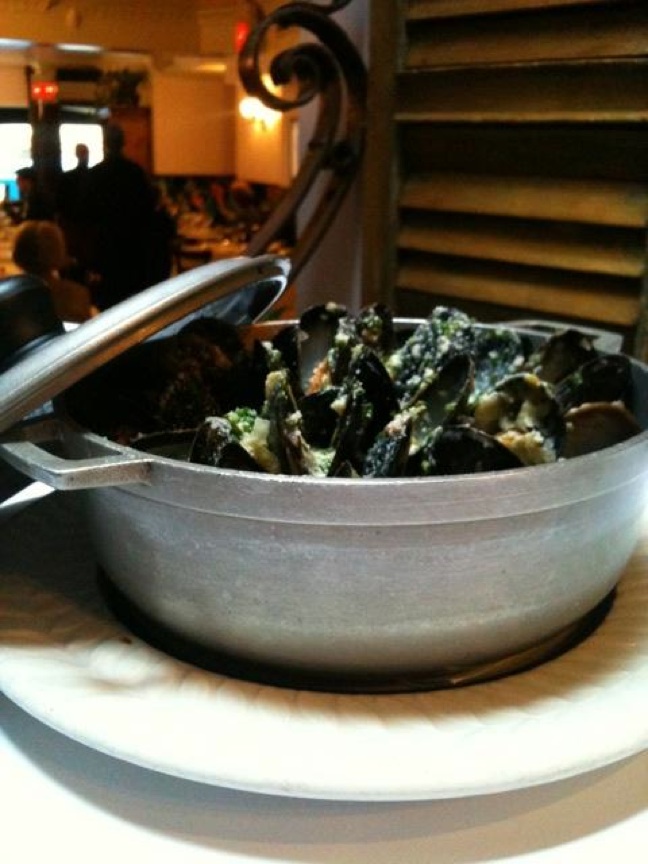 wooden
chairs.
The
greeting is warm, the waiters overworked, and the menu, if
not set in stone, unvarying from years past. Still, nothing I
tasted had the slghtest whiff of ennui from the kitchen; instead, many
of the old dishes tasted as bright as when I first fell in love with
them, right down to the frites
(oddly enough, called French fries here).
wooden
chairs.
The
greeting is warm, the waiters overworked, and the menu, if
not set in stone, unvarying from years past. Still, nothing I
tasted had the slghtest whiff of ennui from the kitchen; instead, many
of the old dishes tasted as bright as when I first fell in love with
them, right down to the frites
(oddly enough, called French fries here).
No discussion of Jubilee ever
begins with anything but mention of its marvelous mussels selection (right), from a superbly spiced and
creamy curried version with coconut milk, shallots, and lemongrass to
the hefty gratinée with béchamel
or à la
provençale with garlic and parsley butter. You'll
probably see at least one serving of them on every table.
Hard as those mussels are to
resist, try the silky mousse of truffled chicken livers, almost as good
as if made with foie gras and better for have a hint of New York's love
of chicken livers. French onion soup was quite good, though it
might have had a better caramelized broth.
When our waiter announced a special of
prawns, I asked twice if they were really prawns, not jumbo shrimp, and
he said, yes they had come in and Chef Fredi Tito was making them that
night simply grilled. 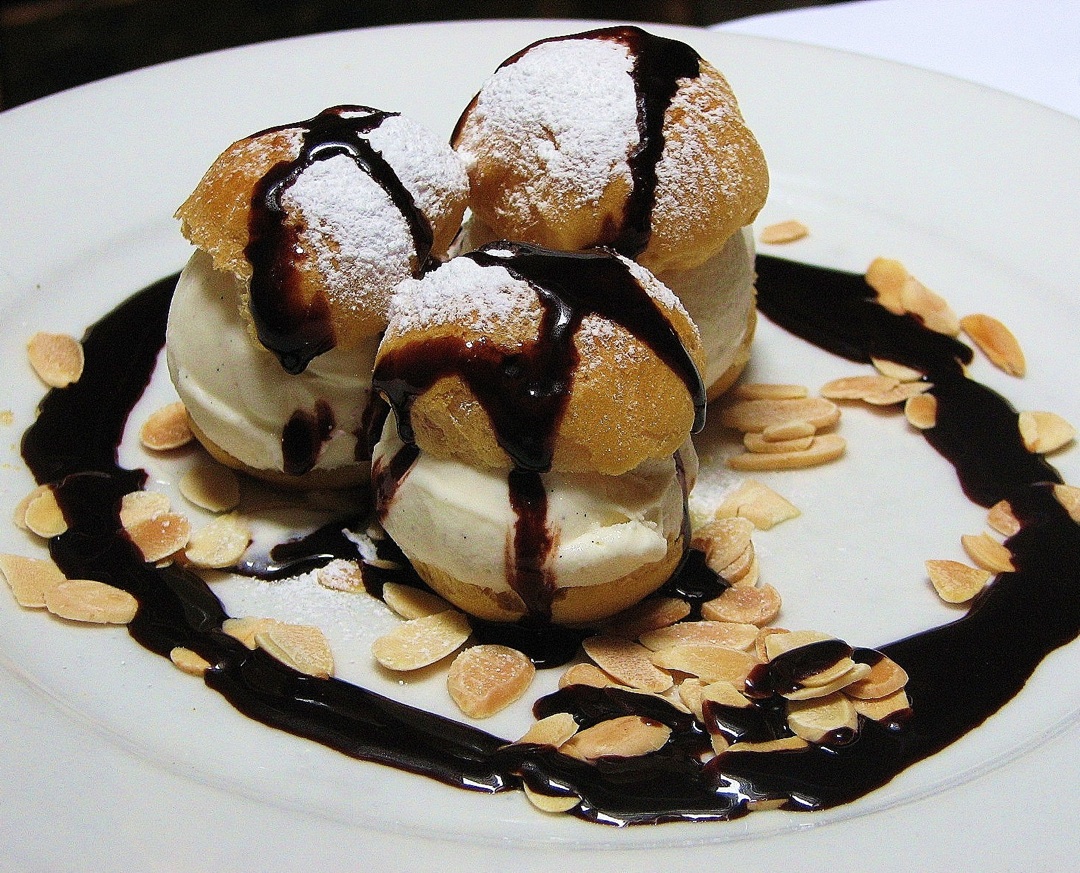 They were terrific, meaty and not at all expensive, as
they tend to be elsewhere. Sweet sea scallops were roasted to a creamy
turn, with orzo pasta, porcini and
a
dusting
of Parmesan cheese. A grilled Black Angus steak with French
fries and a green peppercorn sauce really took me back to the days when
that was a classic rendering on every bistro menu in New York. I
loved it. Roast rack of lamb had the right amount of fat to trim,
served with a luscious potato gratin and a jus scented with rosemary.
They were terrific, meaty and not at all expensive, as
they tend to be elsewhere. Sweet sea scallops were roasted to a creamy
turn, with orzo pasta, porcini and
a
dusting
of Parmesan cheese. A grilled Black Angus steak with French
fries and a green peppercorn sauce really took me back to the days when
that was a classic rendering on every bistro menu in New York. I
loved it. Roast rack of lamb had the right amount of fat to trim,
served with a luscious potato gratin and a jus scented with rosemary.
The
wine
list is very user friendly, not vast but judiciously priced.
Such
food
cries out for a good ending, and the old favorites are all
here--crème brûlée, apple tart, profiteroles (left), and a soft-centered
chocolate cake, every one a reminder of how good taste endures.
As does Jubilee, which has
become my favorite "discovery." It just took a lot longer than it
should have.
Jubilee's dinner appetizers run
$8.50-$14, musels $14, main courses $23.50-$31.50, with a 3-course prix
fixe at $25 served Mon.-Fri. from 5:30-7 PM. Open Mon.-Fri. for
lunch, brunch on Sunday, nightly for dinner.

MAN ABOUT TOWN
by Christopher Mariani
The W Retreat and Spa – Vieques, Puerto Rico
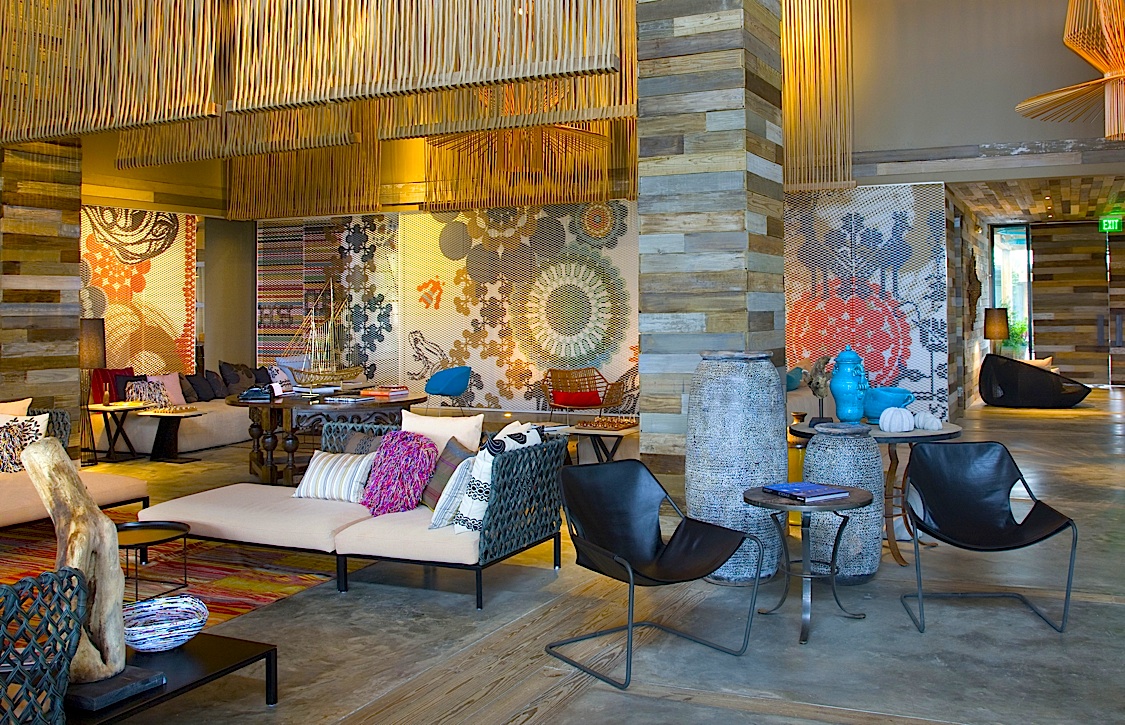 After
a
long
week of hard
work, dining at some of NYC’s best restaurants, attending two posh
parties, and testing out some terrific Italian wines, I was asked, yet again, if I could work over the
weekend. So I packed my bags and jumped on the first flight down
to San
Juan, Puerto Rico. After a two hour layover due to “inclement
weather,” as the rain fell ever so gently, I boarded an
eight-passenger, two-propeller
plane and headed east to the tiny island of Vieques where I would be
staying at
the new W Retreat and Spa.
After
a
long
week of hard
work, dining at some of NYC’s best restaurants, attending two posh
parties, and testing out some terrific Italian wines, I was asked, yet again, if I could work over the
weekend. So I packed my bags and jumped on the first flight down
to San
Juan, Puerto Rico. After a two hour layover due to “inclement
weather,” as the rain fell ever so gently, I boarded an
eight-passenger, two-propeller
plane and headed east to the tiny island of Vieques where I would be
staying at
the new W Retreat and Spa.
Upon
arrival into Vieques
airport, no larger than two acres in size, with just one small landing
strip, I
was directed towards the W’s airport lounge, offering ice cold
Champagne,
homemade chocolate chip cookies, bite-size sandwiches, and chocolate
covered
almonds, all of which I scarfed down. I must say, it was a
well-needed refueling after such a long day of travel, and a wonderful
way to begin my weekend.
After a short stay in the lounge, the W’s silver Jeep pulled up
and drove
me directly to the property, literally five minutes from the
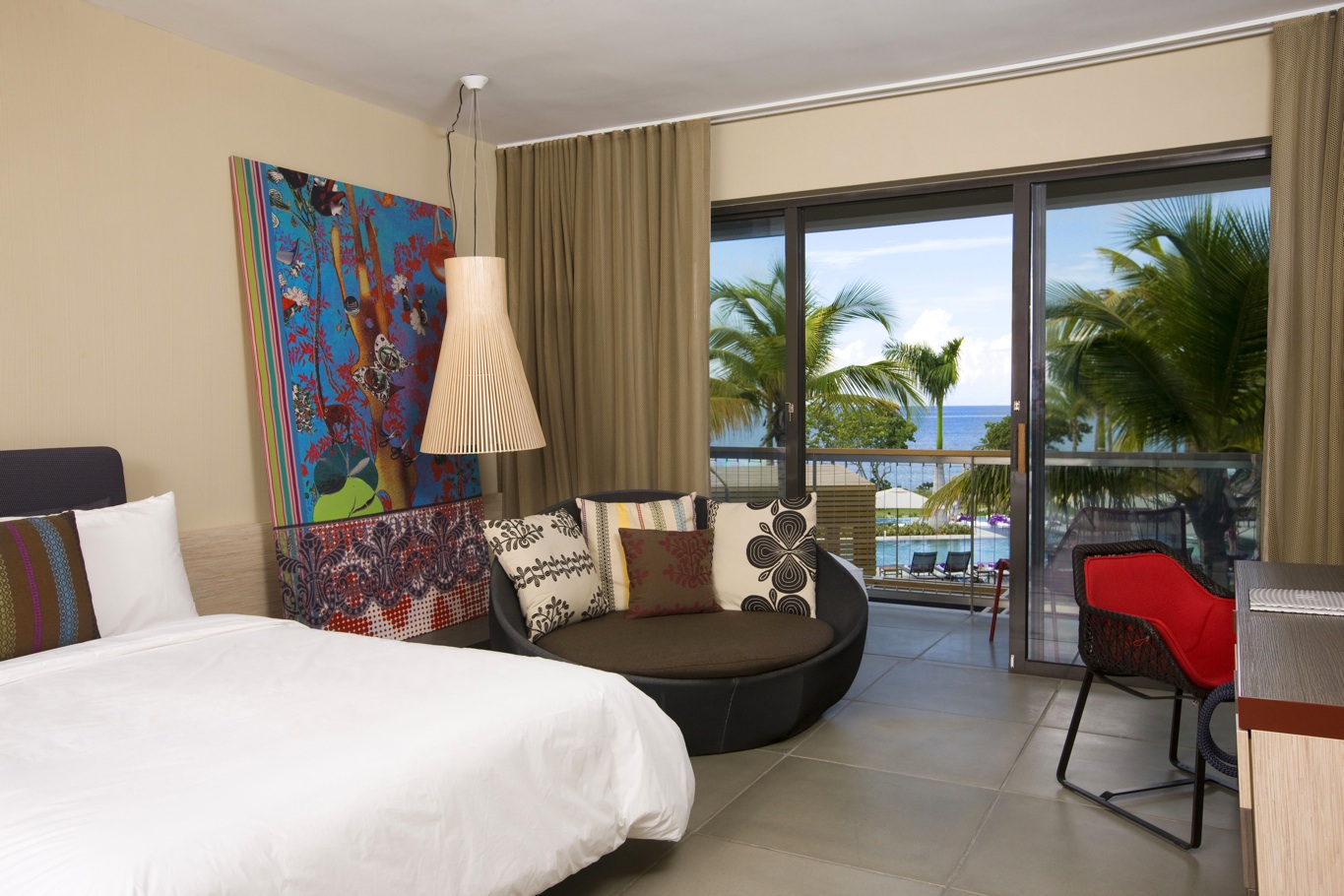 airport.
I
was quickly checked in, then walked
through the hotel’s “living room,” filled with multi-colored lounge
chairs and
pillows, grand murals, a pool table, a lively eight-seat bar, and
off to the side, Alain Ducasse’s inspired Mix on the Beach restaurant, all
created by designer Patricia Urquiola.
airport.
I
was quickly checked in, then walked
through the hotel’s “living room,” filled with multi-colored lounge
chairs and
pillows, grand murals, a pool table, a lively eight-seat bar, and
off to the side, Alain Ducasse’s inspired Mix on the Beach restaurant, all
created by designer Patricia Urquiola.
As a whole, the property was
stunning and a form fit for the almost barren island of
Vieques. The rooms (right)
are trendy in design, within unimposing
three-story buildings that run parallel to the gorgeous Vieques
beachfront, and
centered around enormous king-size beds surrounded by mesh drapes with
a
particularly romantic cast. Behind the bed sits an open bathroom
with a
full-size bathtub and a separate shower area made of black polished
tile, with a
fixed showerhead. The rooms are impressive, possibly the
highlight
of the property, and even have an outside patio with two lounge chairs
set up
for relaxing and taking cover from the island’s hot sun. There
are two
sections of rooms: the first border the hotel’s two shallow rectangular
pools,
occupied by lively guests serenaded by loud, bass-filled music.
The second section is
far more private, set along the beachside of the property, great for
those
looking to feel secluded from other guests.
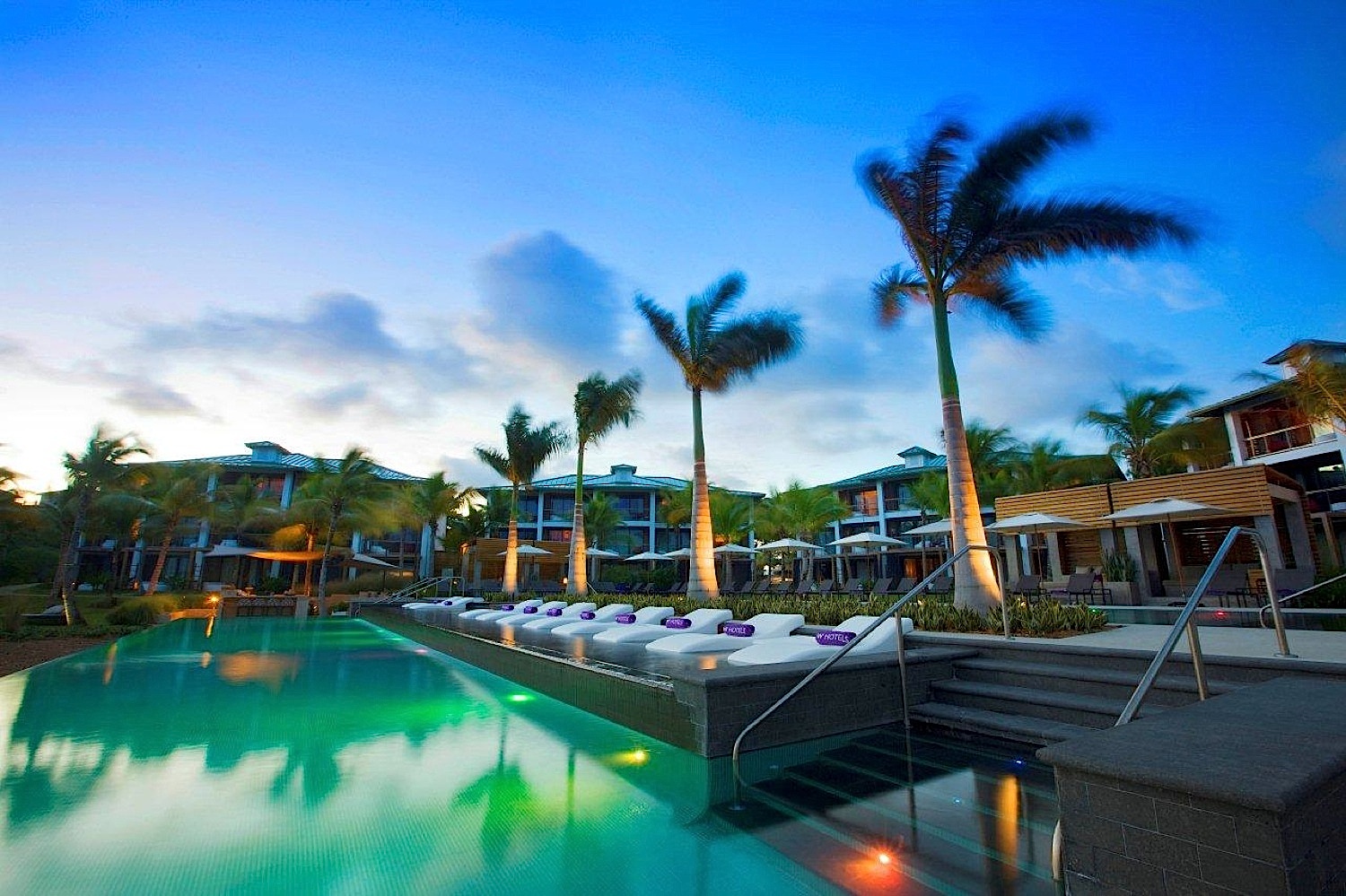 My
days
were
spent by the pool (left) in
one of the W’s beige-draped cabanas,
drinking a
few Dolce Havana’s, a cocktail composed of dark rum, Campari,
triple sec, orange juice and a touch of
housemade syrup. I also tried Puerto Rico’s local beer
Medalla. The resort is great for unwinding, and the natural
scenery stellar, so sit back, enjoy a drink and take in some vitamin D.
One rainy
afternoon I headed to the W’s spa, where I received an amazing Swedish
massage. The private massage rooms are staggered and each have
their very
own
outdoor shower, a great way to finish off such a relaxing massage, much
better
than entering a locker room.
My
days
were
spent by the pool (left) in
one of the W’s beige-draped cabanas,
drinking a
few Dolce Havana’s, a cocktail composed of dark rum, Campari,
triple sec, orange juice and a touch of
housemade syrup. I also tried Puerto Rico’s local beer
Medalla. The resort is great for unwinding, and the natural
scenery stellar, so sit back, enjoy a drink and take in some vitamin D.
One rainy
afternoon I headed to the W’s spa, where I received an amazing Swedish
massage. The private massage rooms are staggered and each have
their very
own
outdoor shower, a great way to finish off such a relaxing massage, much
better
than entering a locker room.
That evening I dined at Mix on the Beach (below), run by Executive chef Dagan Lynn. The interior is decorated with beige and cream tones, dark wood tables, a giant glass-cased wine rack and optional outside dining rimmed by standing torches. The evening’s dinner consisted of a roasted lobster topped with a curry sauce and sided with coconut basmati rice, followed by a Peking duck breast plated with breadfruit, turnips, radish and a dolche forte sauce. And for dessert, chef Lynn kept it light by serving a roasted mango, lightly seasoned and served with a tropical fruit sorbet.
The
following
night’s
dinner at W's La Pescadora,
showcased what I thought to be as chef Lynn’s best and
natural 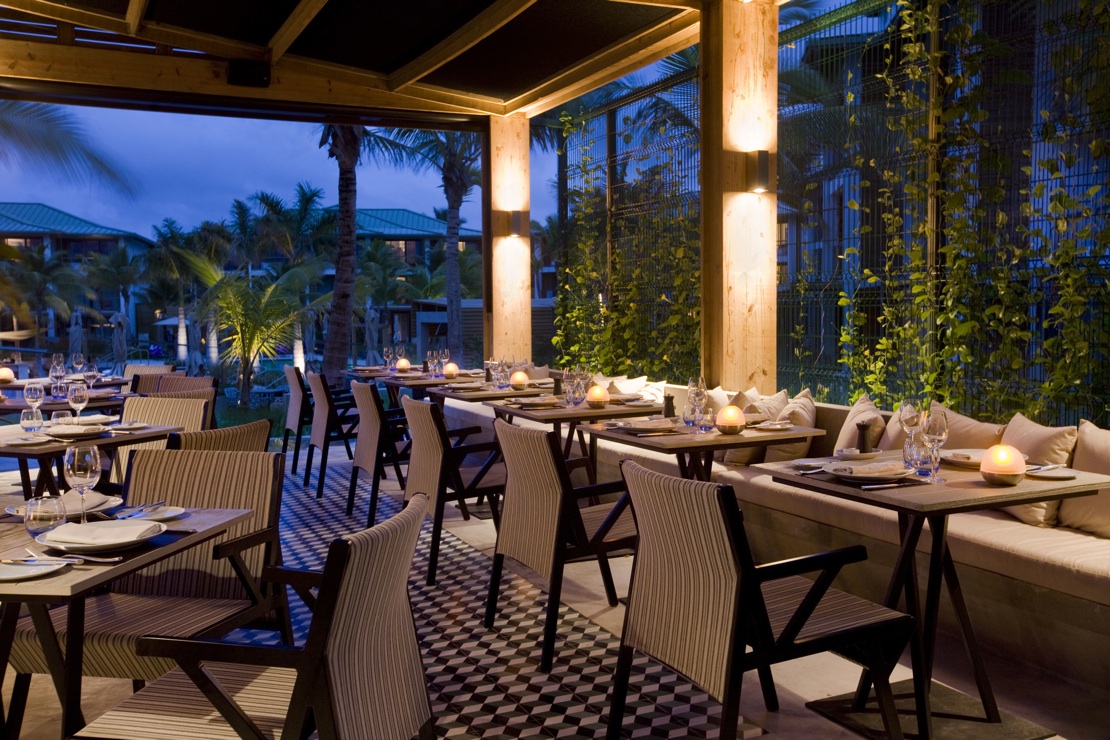 talent,
grilled fresh seafood served with terrific sauces and
local
seasonings. La Pescadora is a small wooden dining area placed
directly on
the beach--no closed toe shoes!--lit by torches and
surrounding a massive grill and bar where Lynn
personally cooks your dinner, using whatever local seafood is
available that
day. The experience is very personal and I highly recommend it, if you
can get a reservation: just insist that the you were told
you could have whatever and whenever,
which
fortunately
happens to be the resort's slogan. That evening
Lynn
started us off with a light and citrusy ceviche made with local fish,
calamari, camarones, fresh coconut
milk and lemon. He then served two salads, one made of an escabeche with malanga and batatas,
the
second with octopus. For
the main dish, I ate two plates of succulent grilled cuttlefish and
Caribbean
lobster accompanied by a housemade hot sauce, a tomato salsa with
raw onions, and
fresh mint leaf pure. And to finish off the night we were
presented with
a seemingly bottomless plate of churros coated
by sugar and cinnamon, and accompanied by a big bowl of dark chocolate
sauce
for dipping. Throughout the meal I opted for La Pescadora’s tequila
tasting, including Patrón Silver, Sauza Hacienda, and Sauza Tres
Generaciones.
This was my last night on the island of Vieques and what a perfect way
to end
such a long and straining weekend of hard work. It was back to
NYC the next day for dinner and a late night party.
talent,
grilled fresh seafood served with terrific sauces and
local
seasonings. La Pescadora is a small wooden dining area placed
directly on
the beach--no closed toe shoes!--lit by torches and
surrounding a massive grill and bar where Lynn
personally cooks your dinner, using whatever local seafood is
available that
day. The experience is very personal and I highly recommend it, if you
can get a reservation: just insist that the you were told
you could have whatever and whenever,
which
fortunately
happens to be the resort's slogan. That evening
Lynn
started us off with a light and citrusy ceviche made with local fish,
calamari, camarones, fresh coconut
milk and lemon. He then served two salads, one made of an escabeche with malanga and batatas,
the
second with octopus. For
the main dish, I ate two plates of succulent grilled cuttlefish and
Caribbean
lobster accompanied by a housemade hot sauce, a tomato salsa with
raw onions, and
fresh mint leaf pure. And to finish off the night we were
presented with
a seemingly bottomless plate of churros coated
by sugar and cinnamon, and accompanied by a big bowl of dark chocolate
sauce
for dipping. Throughout the meal I opted for La Pescadora’s tequila
tasting, including Patrón Silver, Sauza Hacienda, and Sauza Tres
Generaciones.
This was my last night on the island of Vieques and what a perfect way
to end
such a long and straining weekend of hard work. It was back to
NYC the next day for dinner and a late night party.
Rooms
range
from
a standard room at $275 per night and up
to $999 for the premiere suites. The W Vieques also has a wide
range of
rooms with different prices in between, go to the hotel
website.
```````````````````````````````````````````````````````````````````````````````
NOTES FROM THE SPIRITS LOCKER
American Whiskies
Lower
the Burn in Small Batch Bottlings
by John Mariani
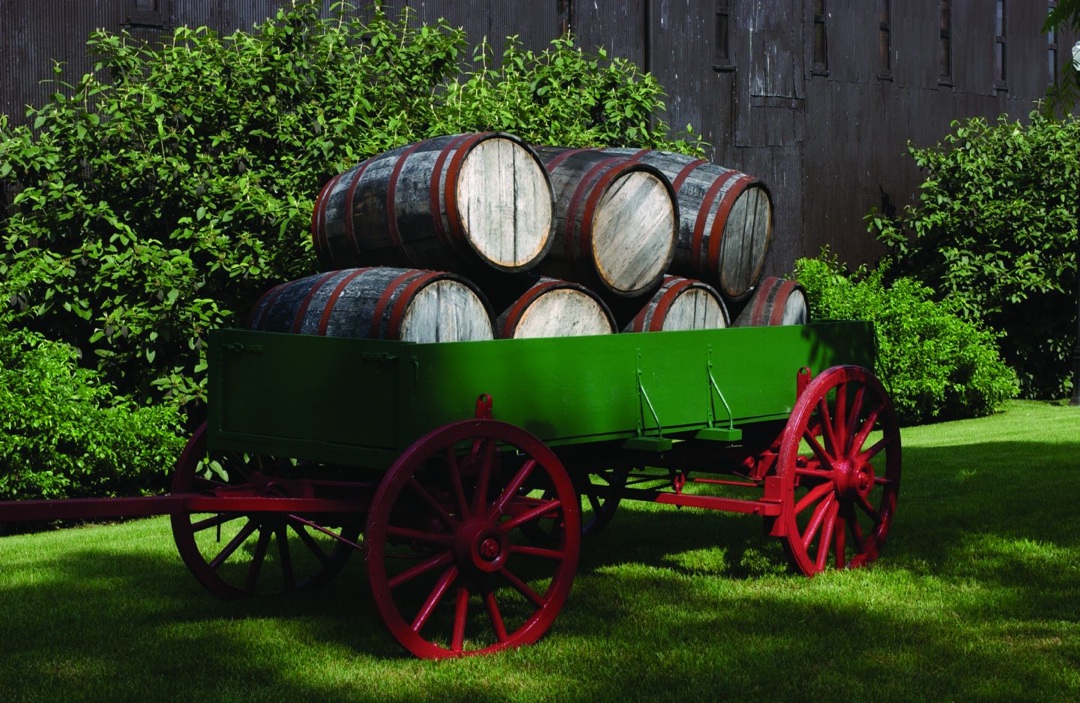 It
was the “burn” that was the problem.
It
was the “burn” that was the problem.
“Back in the 1980s the bourbon industry was dying,” Bill Samuels, Jr., President of Maker’s Mark, told me over dinner at Pat’s Steakhouse in Louisville, KY. “Distilleries were closing, people were out of work, and the whole category was regarded as unsophisticated brown liquor with too much burn on the palate. Traditional bourbons were regarded as something your grandpa drank on the porch. Thank God for Kentucky Derby Day—at least a lot of bourbon got sold in mint juleps.”
It was Samuels, 70, with his father Bill, Sr., who singlehandedly brought bourbon back to favor in 1958 with a slightly sweeter and much smoother spirit called Maker’s Mark, made in copper stills of the kind most bourbon producers had largely abandon
With
Maker’s
Mark
success, things
changed rapidly, and Kentucky’s ten distilleries have all changed
formulas,
styles, and marketing, in particular coming out with new products
called “small
batch” and “single barrel” styles, especially from the Buffalo Trace
Distillery
(owned by the Sazerac Company), whose 2010 Antique Collection of
limited-release bourbons include Eagle Rare 17 Year Old, George T.
Stagg uncut
and unfiltered 143 proof, and William Larue Weller, a wheat recipe
bourbon also
uncut and unfiltered, at 126.6 proof.
According
to
the
Distilled
Spirits Council, in 2009, a healthy 15,064,000 9-liter
cases of
bourbon & Tennessee whiskey were sold in the US.
Facing such rampant competition,
Bill Samuels knew Makers Mark (owned by Fortune Brands) had to come up
with its
own new product without distancing its faithful customer base. “We’d spent so much time and focus on
simply not screwing up the product that we didn’t innovate,” says
Samuels, who
once studied rocket science, then law, before joining the family
bourbon
business in 1975. “We knew we had
problems with the burn on the back of the palate, which comes mainly
from
grains. We asked ourselves, can we create a bourbon in the Maker’s Mark
style
people already love that is really, well, yummy.”
Together with
Master Distiller Kevin Smith, Samuels sought
to intensify
Makers Mark’s nose, length and style of finish. After numerous
attempts, they
turned to Brad Boswell of Independent Stave Company, who recommended
Maker’s
bourbon be finished in the original aging barrels but with the
insertion of
one-inch thick French oak staves seared (“toasted”) on both sides,
which over
two to three months further aging imparted considerable sweet spice to
the
bourbon.
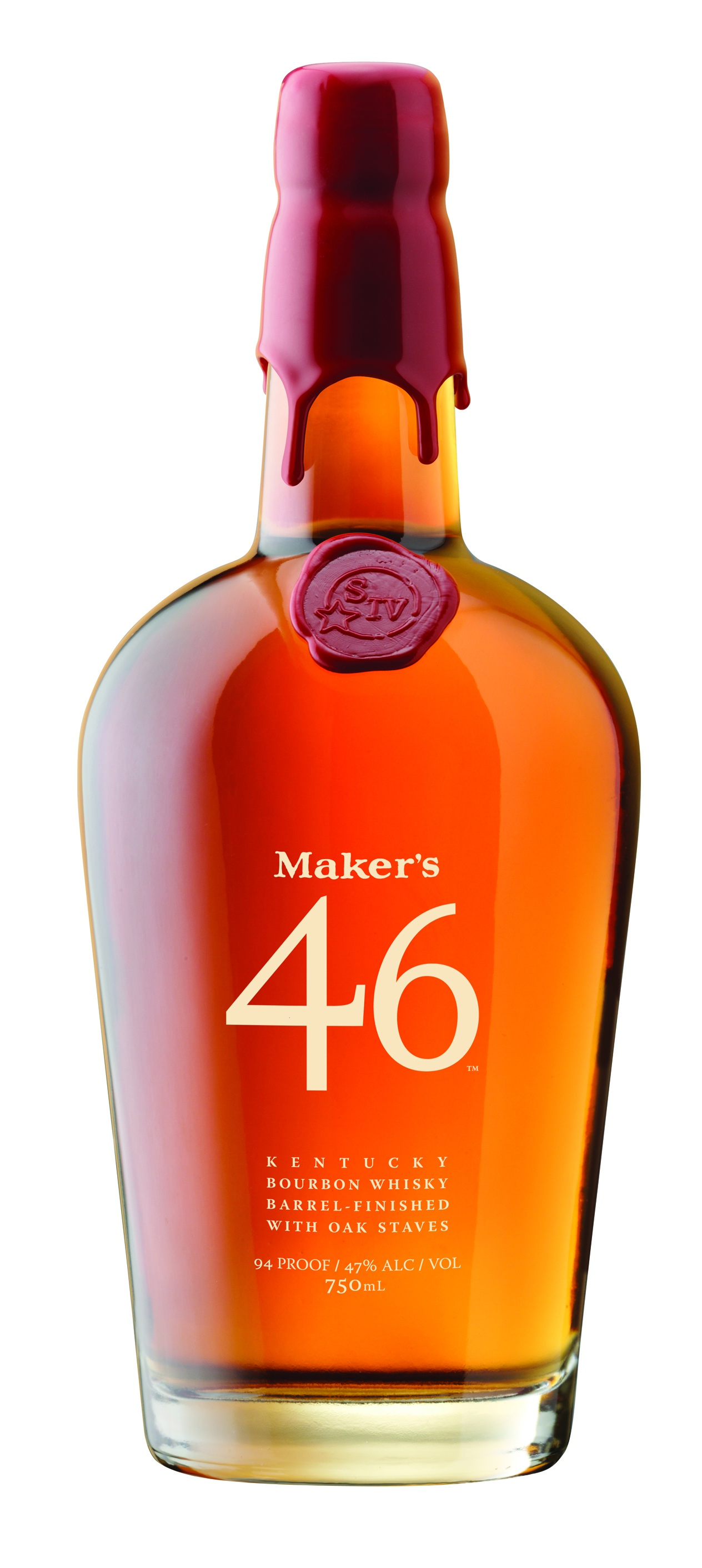 The result was “46,” of which
Samuels says, ”Maker’s Mark was created in the 1950s for people who
didn’t like
bourbon; `46’ is for people who like Maker’s Mark as well as other,
more robust
styles of bourbon."
The result was “46,” of which
Samuels says, ”Maker’s Mark was created in the 1950s for people who
didn’t like
bourbon; `46’ is for people who like Maker’s Mark as well as other,
more robust
styles of bourbon."
On taking
my first sip of “46,”
which is named after the special staves Boswell created, a tangy, spicy
burn ran
along the edges of my palate, not the back of it. It tasted of cinnamon
and
black pepper, followed by vanilla and caramel notes, then a very long,
lingering finish with all those components in synch.
It is certainly one of the best bourbons I’ve ever tasted,
and at only about $35 a bottle and 94 proof, compared to the original
Maker’s
Mark at $25 at 90 proof, it’s an achievement that in just a few months
of
release has become a cult favorite.
Samuels
rolled “46” out without
fanfare or advertising, yet 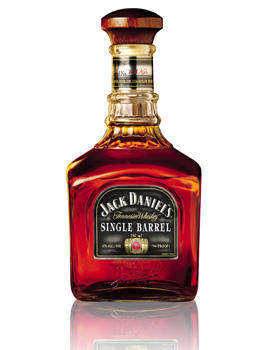 the 2010 supply of 35,000 cases will be
sold out by
January and will soon be on allocation. Worried that the new bourbon
might cut
into the original Maker’s Mark brand Samuels notes happily that there
has been
“zero negative impact on sales."
the 2010 supply of 35,000 cases will be
sold out by
January and will soon be on allocation. Worried that the new bourbon
might cut
into the original Maker’s Mark brand Samuels notes happily that there
has been
“zero negative impact on sales."
I
also recently had occasion to
taste Jack
Daniel’s Special Barrel Select, which is a Tennessee Whiskey, by law
made with
sour mash and filtered through a thick layer of maple charcoal before
aging.
Jack Daniel’s original formula, called Old. No. 7, was been added to by
Gentleman Jack and, more recently, its Single  Barrel Select, a special bottling to
mark
the
One Hundreth Anniversary of Nashville’s grand Hermitage
Hotel,
whose chef Tyler Brown, conferred with Jack Daniel’s Master Distiller
Jeff
Arnett to choose a cache of just 240 bottles, with a Hermitage Hotel
Centennial
seal. I found it a superb, soft but very bright whiskey, with both an
edge and
a supple sweetness that gave it depth and huge complexity.
Depending on how you look at it, the
availability of this whiskey only at the hotel’s Capitol Grille and Oak
Bar (left) can
be frustrating or good reason to get into the spirit of the hotel’s
history, a
place where a lot of years ago a Tennessee girl named Dinah Shore used
to croon
“Skylark,” “Blues in the Night,” and “I Don’t Want to Walk Without You.”
Barrel Select, a special bottling to
mark
the
One Hundreth Anniversary of Nashville’s grand Hermitage
Hotel,
whose chef Tyler Brown, conferred with Jack Daniel’s Master Distiller
Jeff
Arnett to choose a cache of just 240 bottles, with a Hermitage Hotel
Centennial
seal. I found it a superb, soft but very bright whiskey, with both an
edge and
a supple sweetness that gave it depth and huge complexity.
Depending on how you look at it, the
availability of this whiskey only at the hotel’s Capitol Grille and Oak
Bar (left) can
be frustrating or good reason to get into the spirit of the hotel’s
history, a
place where a lot of years ago a Tennessee girl named Dinah Shore used
to croon
“Skylark,” “Blues in the Night,” and “I Don’t Want to Walk Without You.”
John
Mariani's wine and spirits column appears in Bloomberg Muse News,
from
which
this
story
was
adapted.
Bloomberg
News
covers
Culture
from
art,
books,
and
theater
to
wine,
travel,
and
food
on
a
daily
basis.
~~~~~~~~~~~~~~~~~~~~~~~~~~~~~~
FOOD WRITING 101:
KEEP IDOLATROUS POP CULTURE
REFERENCES TO A BARE MINIMUM
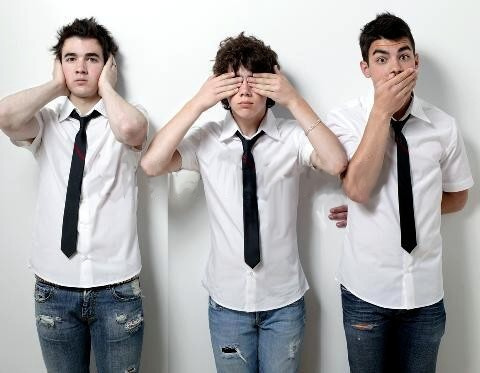 "When it
comes
to other people's kids, there's no shame in admitting you like some
better than
others. I'll be the first to say I prefer Michael over Sonny, Phineas
over
Ferb, and Kevin over the rest of the Jonases."--Carrington Foc,
"Merchants," Nashville Scene
.
"When it
comes
to other people's kids, there's no shame in admitting you like some
better than
others. I'll be the first to say I prefer Michael over Sonny, Phineas
over
Ferb, and Kevin over the rest of the Jonases."--Carrington Foc,
"Merchants," Nashville Scene
.
PIZZA
NOTES
FROM
ALL
OVER
In Buffalo,
NY, restaurateur Joseph Jacobbi, owner
of Casa-di-Pizza, will be feeding pizza
to the poor as
punishment for cheating the state out of sales tax, after pleading guilty to
third-degree grand larceny. A state Supreme Court
judge sentenced
him
to
deliver
12
sheet
pizzas
from his popular restaurant to the
City Mission once a week for a year. . . . Meanwhile, in the UK, the
Pizza Express chain has hired an actor to train employees in the
act of "flirting" to build business.
`````````````````
QUICK BYTES
✉ Guidelines for submissions: QUICK BYTES publishes only events, special dinners, etc, open to the public, not restaurant openings or personnel changes. When submitting please send the most pertinent info, incl. tel # and site, in one short paragraph as simple e-mail text, WITH DATE LISTED FIRST, as below. Thanks. John Mariani
NOTE WELL: OWING TO THE NUMBER OF THANKSGIVING-RELATED EVENT ITEMS SUBMITTED TO THE VIRTUAL GOURMET, IT IS IMPOSSIBLE TO INCLUDE ANY BUT THE MOST EXTRAORDINARY.
* On Nov. 21
six Portland chefs pair up with six
Oregon beers for a battle for The
Monaco Cup, to raise funds for United Way. Hosted by Oregon
Brewers Guild and Monaco Portland, guests select their favorite pairing
from
restaurants like Wildwood and Cafe Nell.
$20 pp, incl. 6 small plates and pairings. .eventbrite.com/event/970937099
* On Nov. 26-27 at Qualia resort on Hamilton Island, Great Barrier Reef, Australia hosts Part 3 of the Great Barrier Feast w/ Guest Chef Ben Shewry, one of 2009’s “Top 20 Rising Stars” in Food & Wine magazine. Beachside food & wine pairings, incl. Oatley wines, and a master chef class will round-out this exciting alternative to a traditional Thanksgiving weekend. Visit www.hamiltonisland.com.au/feast.
*
On Nov.
26 Yountville’s 22nd Annual Festival of Lights, with
carolers, shopping,
food and wine events and Santa Sommelier. Tickets for food and wine
required.
Visit yountville.com.
* On Thursday, November 11, 2010
in Las Vegas, NV Thirsty
Girl LIVE! will be at Sushisamba in the Palazzo Hotel. Founded by
Leslie Sbrocco, author, hostof PBS Show "Check Please Bay Area."
From 6:00 PM - 8:00 PM PST enjoy sushi, sashimi and ceviche and learn
about wine and food pairings. Buy tickets online at http://tglasvegas.eventbrite.com/.
Everett Potter's Travel Report:

~~~~~~~~~~~~~~~~~~~~~~~~~~~~~~~~~~~~~~~~~~~~~~~~~~~~~~~~~~~~~~~~~~~~~~~~~~
Eating Las Vegas is the new on-line site for Virtual Gourmet contributor John A. Curtas., who since 1995 has been commenting on the Las Vegas food scene and reviewing restaurants for Nevada Public Radio. He is also the restaurant critic for KLAS TV, Channel 8 in Las Vegas, and his past reviews can be accessed at KNPR.org. Click on the logo below to go directly to his site.
~~~~~~~~~~~~~~~~~~~~~~~~~~~~~~~~~~~~~~~~~~~~~~~~~~~~~~~~~~~~~~~~~~~~~~~~~~~
Tennis Resorts Online: A Critical Guide to the World's Best Tennis Resorts and Tennis Camps, published by ROGER COX, who has spent more than two decades writing about tennis travel, including a 17-year stretch for Tennis magazine. He has also written for Arthur Frommer's Budget Travel, New York Magazine, Travel & Leisure, Esquire, Money, USTA Magazine, Men's Journal, and The Robb Report. He has authored two books-The World's Best Tennis Vacations (Stephen Greene Press/Viking Penguin, 1990) and The Best Places to Stay in the Rockies (Houghton Mifflin, 1992 & 1994), and the Melbourne (Australia) chapter to the Wall Street Journal Business Guide to Cities of the Pacific Rim (Fodor's Travel Guides, 1991).

Family Travel
Forum: The
Family
Travel
Forum
(FTF),
whose
motto
is
"Have
Kids,
Still
Travel!",
is
dedicated
to
the
ideals,
promotion
and
support
of
travel
with
children.
Founded
by business professionals John Manton and Kyle
McCarthy with first class travel industry credentials and global family
travel experience, the independent, family-supported FTF will provide
its members with honest, unbiased information, informed advice and
practical tips; all designed to make traveling a rewarding, healthy,
safe, better value and hassle-free experience for adults and children
who journey together. Membership in FTF will lead you to new worlds of
adventure, fun and learning. Join the movement.
All You Need to Know Before You Go
nickonwine: An engaging, interactive wine column by Nick Passmore, Artisanal Editor, Four Seasons Magazine; Wine Columnist, BusinessWeek.com; nick@nickonwine.com; www.nickonwine.com.

MARIANI'S VIRTUAL GOURMET NEWSLETTER is published weekly. Editor/Publisher: John Mariani.
Contributing Writers: Christopher
Mariani, Robert Mariani,
John A. Curtas, Edward Brivio, Mort
Hochstein, Suzanne Wright, and Brian Freedman. Contributing
Photographers: Galina Stepanoff-Dargery, Bobby Pirillo. Technical
Advisor:
Gerry McLoughlin.
Any of John Mariani's books below
may be ordered from amazon.com by clicking on the cover image.
 My
newest book, written with my brother Robert Mariani, is a memoir of our
years growing up in the My
newest book, written with my brother Robert Mariani, is a memoir of our
years growing up in the For those of you who don't think of the Robert and I think you'll enjoy this very personal look at our --John Mariani |
 |
 |
 |
 |
 |
 |
© copyright John Mariani 2010
